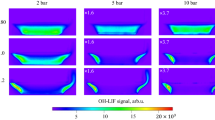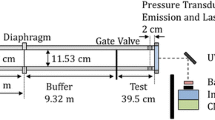Abstract
Combustion in a turbulent boundary layer over a solid fuel is studied using simultaneous schlieren and OH* chemiluminescence imaging. The flow configuration is representative of a hybrid rocket motor combustor. Six different hydrocarbon fuels, including both classical hybrid rocket fuels and a high regression rate fuel (paraffin wax), are burned in an undiluted oxygen free-stream at pressures ranging from atmospheric to 1524.2 kPa (221.1 psi). A detailed explanation of methods for registering the schlieren and OH* chemiluminescence images to one another is presented, and additionally, details of the routines used to extract flow features of interest (like the boundary layer height and flame location) are provided. At atmospheric pressure, the boundary layer location is consistent between all fuels; however, the flame location varies for each fuel. The flame zone appears to be smoothly distributed over the fuel surface at atmospheric pressure. At elevated pressures and correspondingly increased Dahmköhler number (but at constant Reynolds number), flame morphology is markedly different, exhibiting large rollers in a shear layer above the fuel grain and finer structures in the flame. The chemiluminescence intensity is found to be roughly proportional to the fuel burn rate at both atmospheric and elevated chamber pressures.











Similar content being viewed by others
Notes
The term hot-fire refers to a test with combustion, as compared to a cold-flow where oxygen flows through the combustion chamber without ignition.
This projection angle is calculated from the mean horizontal distortion of the OH* grid images.
MATLAB does not allow the use of two distinct colormaps to be used in a single figure.
Abbreviations
- \(\Delta m_{f}\) :
-
Mass of fuel burned (kg)
- \(\delta\) :
-
Boundary layer thickness (m)
- \(\Delta h_{b}\) :
-
Total change in fuel height (m)
- \(\dot{m}_{f}\) :
-
Fuel burn rate (kg/s)
- \(\dot{r}\) :
-
Regression rate (m/s)
- \(\dot{\omega }\) :
-
Mass-based reaction rate (kg/m\(^{3}\) s)
- \(\rho _{f}\) :
-
Fuel density (kg/m\(^{3}\))
- \(\tau _\mathrm{chem}\) :
-
Characteristic chemical reaction time (s)
- \(\tau _\mathrm{fluid}\) :
-
Characteristic fluid mixing time (s)
- A :
-
Frequency factor for the reaction
- a, b :
-
Reaction orders
- \(A_{b}\) :
-
Surface burning area (m\(^{2}\))
- Da :
-
Damköhler number
- \(E_{a}\) :
-
Activation energy (J/mol)
- \(G_{ox}\) :
-
Oxidizer mass flux (kg/m\(^{2}\) s)
- I :
-
Intensity (a.u.)
- k :
-
Gladstone–Dale coefficient
- \(M_{f}\) :
-
Molar mass of fuel (kg/mol)
- \(M_{o}\) :
-
Molar mass of oxidizer (kg/mol)
- n :
-
Refractive index
- \(R^{2}\) :
-
Coefficient of determination
- \(R_{u}\) :
-
Universal gas constant (J/mol K)
- T :
-
Temperature (K)
- \(t_{b}\) :
-
Burn time (s)
- \(U_{\infty }\) :
-
Free-stream velocity (m/s)
- \(Y_{f}\) :
-
Mass fraction of fuel
- \(Y_{o}\) :
-
Mass fraction of oxidizer
References
Burcat A, Lifshitz A, Scheller K, Skinner GB (1971) Shock-tube investigation of ignition in propane-oxygen-argon mixtures. In: Symposium (international) on combustion, Elsevier, vol 13, pp 745–755
Chandler AA (2012) An investigation of liquefying hybrid rocket fuels with applications to solar system exploration. PhD thesis, Stanford University
Chandler AA, Jens ET, Cantwell BJ, Hubbard GS (2012) Visualization of the liquid layer combustion of paraffin fuel for hybrid rocket applications. In: 48th AIAA/ASME/SAE/ASEE joint propulsion conference & exhibit, joint propulsion conferences, American Institute of Aeronautics and Astronautics. doi:10.2514/6.2012-3961
Chiaverini M (2007) Review of solid-fuel regression rate behavior in classical and nonclassical hybrid rocket motors. American Institute of Aeronautics and Astronautics, pp 37–126. doi:10.2514/5.9781600866876.0037.0126
Corrsin S, Kistler AL (1955) Free-stream boundaries of turbulent flows. NACA-TR-1244
Gonzalez RC, Woods RE, Eddins SL (2004) Digital image processing using MATLAB. Pearson Education India
Guethe F, Guyot D, Singla G, Noiray N, Schuermans B (2012) Chemiluminescence as diagnostic tool in the development of gas turbines. Appl Phys B 107(3):619–636
Jens ET, Mechentel FS, Cantwell BJ, Hubbard GS, Chandler AA (2014a) Combustion visualization of paraffin-based hybrid rocket fuel at elevated pressures. In: 50th AIAA/ASME/SAE/ASEE joint propulsion conference, joint propulsion conferences, American Institute of Aeronautics and Astronautics
Jens ET, Narsai P, Cantwell BJ, Hubbard GS (2014b) Schlieren imaging of the combustion of classical and high regression rate hybrid rocket fuels. In: 50th AIAA/ASME/SAE/ASEE joint propulsion conference, joint propulsion conferences, American Institute of Aeronautics and Astronautics
Jones JW, Isaacson L, Vreekes S (1971) A turbulent boundary layer with mass addition, combustion, and pressure gradients. AIAA J 9(9):1762–1768
Karabeyoglu MA, Cantwell BJ (2002) Combustion of liquefying hybrid propellants: part 2, stability of liquid films. J Propuls Power 18(3):621–630
Karabeyoglu MA, Cantwell BJ, Altman D (2001) Development and testing of paraffin-based hybrid rocket fuels, American Institute of Aeronautics and Astronautics. Joint Propulsion Conferences. doi:10.2514/6.2001-4503
Karabeyoglu MA, Altman D, Cantwell BJ (2002) Combustion of liquefying hybrid propellants: part 1, general theory. J Propul Power 18(3):610–620
Lauer M, Sattelmayer T (2010) On the adequacy of chemiluminescence as a measure for heat release in turbulent flames with mixture gradients. J Eng Gas Turbines Power 132(6):061,502
Marxman GA (1965) Combustion in the turbulent boundary layer on a vaporizing surface. In Symposium (international) on combustion, Elsevier, vol 10, pp 1337–1349
Marxman GA, Gilbert M (1963) Turbulent boundary layer combustion in the hybrid rocket. In: Symposium (international) on combustion, Elsevier, vol 9, pp 371–383
Marxman GA, Muzzy R, Wooldridge C (1963) Fundamentals of hybrid boundary layer combustion. In: Heterogeneous combustion conference, meeting paper archive, American Institute of Aeronautics and Astronautics. doi:10.2514/6.1963-505
Miller VA (2014) High-speed tracer-based PLIF imaging for Scramjet ground testing. PhD thesis, Stanford University
Muzzy R (1963) Schlieren and shadowgraph studies of hybrid boundary layer combustion. AIAA J 1(9):2159–2160
Muzzy R, Wooldridge C (1966) Boundary-layer turbulence measurements with mass addition and combustion. AIAA J 4(11):2009–2016
Panoutsos C, Hardalupas Y, Taylor A (2009) Numerical evaluation of equivalence ratio measurement using OH and CH chemiluminescence in premixed and non-premixed methane-air flames. Combust Flame 156(2):273–291
Settles GS (2001) Schlieren and shadowgraph techniques: visualizing phenomena in transparent media. Springer, Berlin
Smith NT (2013) Schlieren sequence analysis using computer vision. PhD thesis, University of Maryland
Smith NT, Lewis MJ, Chellappa R (2012) Extraction of oblique structures in noisy schlieren sequences using computer vision techniques. AIAA J 50(5):1145–1155
Smith NT, Lewis MJ, Chellappa R (2014) Detection, localization, and tracking of shock contour salient points in schlieren sequences. AIAA J 52(6):1249–1264
Soid S, Zainal Z (2011) Spray and combustion characterization for internal combustion engines using optical measuring techniques-a review. Energy 36(2):724–741
Tomasi C, Manduchi R (1998) Bilateral filtering for gray and color images. In: Sixth international conference on computer vision, 1998. IEEE, pp 839–846
Westbrook CK, Dryer FL (1981) Simplified reaction mechanisms for the oxidation of hydrocarbon fuels in flames. Combust Sci Technol 27(1–2):31–43
Wooldridge C, Muzzy R (1965) Measurements in a turbulent boundary layer with porous wall injection and combustion. In: Symposium (international) on combustion, Elsevier, vol 10, pp 1351–1362
Zilliac G, Karabeyoglu M (2006) Hybrid Rocket Fuel Regression Rate Data and Modeling. In: 42nd AIAA/ASME/SAE/ASEE joint propulsion conference & exhibit, joint propulsion conferences, American Institute of Aeronautics and Astronautics. doi:10.2514/6.2006-4504
Acknowledgments
The authors would like to thank the Jet Propulsion Laboratory’s Strategic University Research Partnership program and the Stanford Center of Excellence in Aeronautics and Astronautics for financial support of this project. E. Jens also acknowledges the support of Zonta International in the form of the Amelia Earhart Fellowship. The authors thank Greg Zilliac, Dr. Rabi Mehta and James Heineck of NASA Ames Research Center for loaning the MotionPro X3 Plus for this work, and Dr. Campbell Carter of the Air Force Research Laboratory for loaning the Photron APX i\(^{2}\).
Author information
Authors and Affiliations
Corresponding author
Rights and permissions
About this article
Cite this article
Jens, E.T., Miller, V.A. & Cantwell, B.J. Schlieren and OH* chemiluminescence imaging of combustion in a turbulent boundary layer over a solid fuel. Exp Fluids 57, 39 (2016). https://doi.org/10.1007/s00348-016-2124-x
Received:
Revised:
Accepted:
Published:
DOI: https://doi.org/10.1007/s00348-016-2124-x




